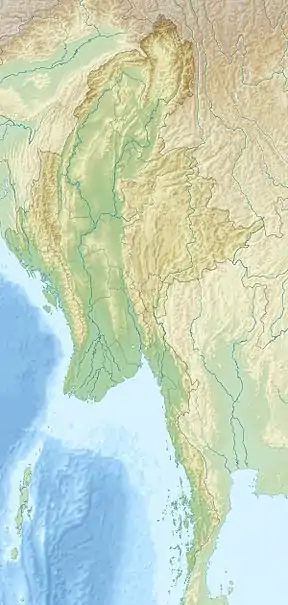| Pyin-O-Lwin Bird Sanctuary | |
|---|---|
| Burmese: ပြင်ဦးလွင် ငှက်ဘေးမဲ့တော | |
IUCN category IV (habitat/species management area) | |
 Pyin-O-Lwin Bird Sanctuary Location in Myanmar | |
| Location | Mandalay Region, Pyinoolwin Township, |
| Nearest city | Pyin-O-Lwin |
| Coordinates | 22°00′00″N 96°30′00″E / 22.00000°N 96.50000°E |
| Area | 127.25 km2 (49.13 sq mi)[1] |
| Established | 1918 |
| Governing body | Forest Department, Ministry of Natural Resources and Environmental Conservation |
Pyin-O-Lwin Bird Sanctuary is a protected area in Myanmar's Pyinoolwin Township in Mandalay Region covering an area of 127.25 km2 (49.13 sq mi).[1] It was gazetted in 1918 and spans an elevation of 975–1,210 m (3,199–3,970 ft).[2] It is one of four protected wetlands.
Description
This sanctuary is near the town of Pyin-O-Lwin. The road linking Anesakhan (Burmese: အနီးစခန်း) and Lashio (Burmese: ပွင့်ဖြူ) towns passes through the sanctuary. It receives south-west monsoon rains of about 1,000 mm (39 in) every year from June to August.[3]
Biodiversity
Pyin-O-Lwin Bird Sanctuary harbours evergreen hill forest. Wildlife present include green peafowl (Pavo muticus), grey peacock pheasant (Polyplectron bicalcaratum) and barking deer (Muntiacus muntjak).[2]
History
Pyin-O-Lwin Bird Sanctuary was gazetted in 1918.[2] It was established in 1927. As of 2017, it is managed by the Forest Department.[4]
Tourism
Pyin-O-Lwin town is a favourite destination for the tourist since, it is located on the main road and railway line from Mandalay to Lashio. Many tourist attractions like National Kandawgyi Gardens (Burmese: အမျိုးသားကန်တော်ကြီးဥယျာဉ်), flower garden have resulted in need to develop Pyin-O-Lwin Bird sanctuary. Regular educated forest staff is in need to direct the local and foreign tourist visiting the sanctuary.
Threats
References
- 1 2 World Database on Protected Areas (2019). "Pyin-O-Lwin Bird Sanctuary". Protected Planet.
- 1 2 3 Beffasti, L.; Gallanti, V., eds. (2011). "Pyin-O-Lwin". Myanmar Protected Areas: Context, Current Status and Challenges (PDF). Milano, Yangon: Istituto Oikos, Biodiversity and Nature Conservation Association. p. 82.
- ↑ "Climate - Burma". Climates to Travel. Retrieved 29 November 2019.
- ↑ Lazarus, K. M.; Cardinale, P.; Corbett, M.; Lin, N. S.; Noeske, T. K. H. (2017). "Baseline Assessment Report of Terrestrial Biodiversity" (PDF). Strategic Environmental Assessment of the Hydropower Sector in Myanmar. Washington, D.C.: International Finance Corporation.
- ↑ "Pyin Oo Lwin sanctuary expanded". Myanmar Times. 2010. Retrieved 30 November 2019.